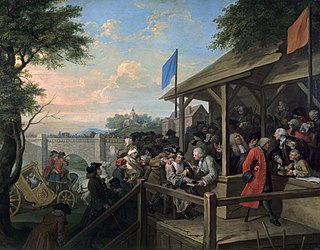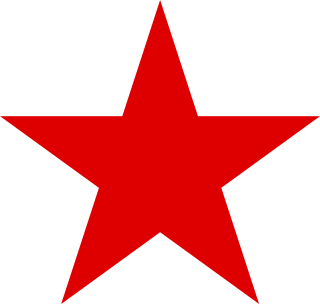
The national flag of Slovenia features three equal horizontal bands of white (top), blue, and red, with the coat of arms of Slovenia located in the upper hoist side of the flag centred in the white and blue bands. The coat of arms is a shield with the image of Mount Triglav, Slovenia's highest peak, in white against a blue background at the centre; beneath it are two wavy blue lines representing the Adriatic Sea and local rivers, and above it are three six-pointed golden stars arranged in an inverted triangle which are taken from the coat of arms of the Counts of Celje, the great Slovene dynastic house of the late 14th and early 15th centuries.

The State Flag of the Union of Soviet Socialist Republics, commonly known as the Soviet flag, was the official state flag of the Union of Soviet Socialist Republics (USSR) from 1922 to 1991. The flag's design and symbolism are derived from several sources, but emerged during the Russian Revolution. The flag is also an international symbol of the communist movement as a whole.

The hammer and sickle is a symbol meant to represent proletarian solidarity, a union between agricultural and industrial workers. It was first adopted during the Russian Revolution at the end of World War I, the hammer representing workers and the sickle representing the peasants.

The flag of North Macedonia is the national flag of the Republic of North Macedonia and depicts a stylized yellow sun on a red field, with eight broadening rays extending from the center to the edge of the field. It was created by Miroslav Grčev and was adopted on 5 October 1995.

In politics, a red flag is predominantly a symbol of socialism, communism, Marxism, trade unions, left-wing politics, and anarchism. The originally empty or plain red flag has been associated with left-wing politics since the French Revolution (1789–1799).

Political colours are colours used to represent a political ideology, movement or party, either officially or unofficially. They represent the intersection of colour symbolism and political symbolism. Politicians making public appearances will often identify themselves by wearing rosettes, flowers, ties or ribbons in the colour of their political party.

The Galician Nationalist Bloc is a political alliance of left-wing Galician nationalist parties. It is self-defined as a "patriotic front".

The flag of Kazakhstan or Kazakh flag was adopted on 4 June 1992, replacing the flag of the Kazakh Soviet Socialist Republic. The flag was designed by Shaken Niyazbekov.

The national flag of Ukraine consists of equally sized horizontal bands of blue and yellow.

A red star, five-pointed and filled, is a symbol that has often historically been associated with communist ideology, particularly in combination with the hammer and sickle, but is also used as a purely socialist symbol in the 21st century. It has been widely used in flags, state emblems, monuments, ornaments, and logos.

The Estelada is an unofficial flag typically flown by Catalan independence supporters to express their support for either an independent Catalonia or independent Països Catalans. The design of the Estelada comprises the red-and-yellow bars of the Senyera, with the addition of a five-pointed star in a triangle at the hoist.
Fascist symbolism is the use of certain images and symbols which are designed to represent aspects of fascism. These include national symbols of historical importance, goals, and political policies. The best-known are the fasces, which was the original symbol of fascism, and the swastika of Nazism.
Transnistria is a region in Eastern Europe that is under the effective control of the self-declared Pridnestrovian Moldavian Republic but is recognized by the international community as an administrative unit of Moldova, the Administrative-Territorial Units of the Left Bank of the Dniester.

The flag of Galicia appeared for first time in the 19th century, probably based on the colours of the ancient medieval flags of the Kingdom of Galicia. Originally, the flag was probably a blue St Andrew's Cross over a white field – St Andrew is one of the most popular saints in Galicia. The coat of arms of Galicia was actually the former flag of the Kingdom of Galicia. The colors blue, white and gold were always related with Galicia. The chalice, with a silver host, and the golden crosses on blue background have been its symbol since medieval times. For some time it was thought that it was based on the flag of the maritime province of Corunna, but today it is known that the design is earlier.

Political symbolism is symbolism that is used to represent a political standpoint or party.

The ikurrina flag or ikurriña is a Basque symbol and the official flag of the Basque Country Autonomous Community of Spain. This flag consists of a white cross over a green saltire on a red field.
The Galician National-Popular Assembly was suprapartisan umbrella organization established in 1975 created to coordinate various political fronts of the left-wing Galician nationalist movement.
Communist symbolism represents a variety of themes, including revolution, the proletariat, the peasantry, agriculture, or international solidarity.














